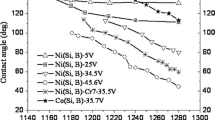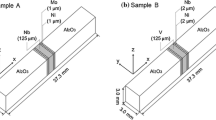Abstract
AlN ceramics are bonded using vanadium metal foils at high temperatures in vacuum. Different bonding temperatures were used in the range 1373–1773 K with bonding times of 0.3–21.6 ks. The AlN/V interfaces of the bonded joints were investigated using SEM, electron probe microanalysis and X-ray diffraction. A bonding temperature of 1573 K was found to be suitable to activate both parts to initiate a phase reaction at the interface, because a thin V(Al) solid solution layer formed adjacent to the ceramic at 1573 K just after 0.9 ks, and a small flake-shaped V2N reaction product formed inside the vanadium central layer. The formation of V(Al) and V2N controls the interfacial joining of the AlN/V system at 1573 K up to 5.4 ks bonding time. The pure vanadium layer quickly changed to vanadium-containing V2N. The diffusion path could be predicted for the AlN/V joints up to 0.9 ks at 1573 K following the sequence AlN/V(Al)/V2N/V, while after 0.9 ks, the interface structure changed to AlN/V(Al)/V2N + V by the growth Of V2N into the vanadium. The AlN/V joints shovyed no ternary compounds at the interface. A maximum bond strength could be obtained for a joint bonded at 1573 K after 5.4 ks having a structure of AlN/V(Al)/V2N + V. At 7.2 ks, nitrogen, resulting from AlN decomposition, escaped and the remaining aluminium reacted with V(Al) to form V5Al8 intermetallic, which is attributable to the decrease in bond strength.
Similar content being viewed by others
References
W. E. BORBIGDE, R. V. ALLEN and P. T. WHELAN, J. Phys. 47 (1986) C1-131.
M. G. NICHOLAS and D. A. MORTIMER, Mater. Sci. Technol. 1 (1985) 657.
P. MARTINEAU, R. PAILLER, M. LAHAYE and R. NASLAIN, J. Mater. Sci. 19 (1984) 2749.
T. TUNABASHI and K. ISOMURA, Ceram. Jpn 26 (1991) 749.
M. H. EL-SAYED, M. NAKA and S. C. SCHUSTER, in “4th International Symposium on Advanced Composites”, Corfu, Greece, 19–22 September 1995, (University of Patras, Applied Mechanics Lab., Patras, 1995) pp. 328-333.
J. C. FENG, T. FUKAI, M. NAKA, and J. C. SCHUSTER, in “6th International Symposium, Japan Weld. Soc.”, Nagoya, Japan (1996) pp. 101-106.
M. H. EL-SAYED, M. NAKA and J. C. SCHUSTER, J. Mater. Sci. 32 (1997) 2715-21.
T. B. MASSALESKI, “Binary Alloy Phase Diagram”, Vol. 1, (ASM, Metals Park, OH, 1987) p. 180.
D. YONG, W. ROLAND and F. SCHMID, in “International Conference on Thermodynamics of Alloys”, Marseilles, France (1991).
X. L. LI, R. HILLEL, F. TEYSSANDIER, S. K. CHOI and F. J. VAN LOO, Acta Metall. Mater. 40 (1992) 3149.
J. C. SCHUSTER and M. NAKA, Materia Jpn Jpn Inst. Metals 34 (1995) 1093.
Powder Diffraction File, 7-360 (International Center for Diffraction Data, Swarthmore, PA, 1967).
Author information
Authors and Affiliations
Rights and permissions
About this article
Cite this article
Ei-Sayed, M.H., Naka, M. Structure and strength of AlN/V bonding interfaces. Journal of Materials Science 33, 2869–2874 (1998). https://doi.org/10.1023/A:1017546105704
Issue Date:
DOI: https://doi.org/10.1023/A:1017546105704




